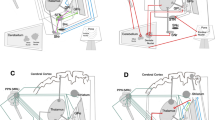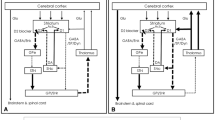Abstract
We report the case of a patient suffering from sudden apathy and pathological gambling-like behaviour after bilateral ischemic lesions involving the dorsal portion of the head of the caudate nuclei and adjacent anterior limb of the internal capsules. This is the first report of the association of an apathy and abnormal gambling behaviour following a stroke affecting sub-cortical structures. Although the location of the lesions, affecting the dorsal striatum, may explain the emergence of an apathetic state, it is, however, at first sight, not easy to explain the gambling behaviour because the patient was normal in tests evaluating sensitivity to reward, and no radiological abnormality was found in the cortical-sub-cortical system of reward. It is proposed that, for this patient, the mechanism of maladaptive gambling behaviour was the development of a routine behaviour related to the patient’s cognitive inertia, a mechanism different from the changes in reward sensitivity observed after damage to the orbital ventral prefrontal–ventral striatum system or in dopamine dysregulation syndrome in Parkinson’s disease.

Similar content being viewed by others
References
Bhatia KP, Marsden CD (1994) The behavioural and motor consequences of focal lesions of the basal ganglia in man. Brain 117:859–876
Alexander GE, Delong MR, Strick PL (1986) Parallel organization of functionally segregated circuits linking basal ganglia and cortex. Annual Rev Neurosci 9:357–381
Middleton FA, Strick PL (2002) Basal-ganglia ‘projections’ to the prefrontal cortex of the primate. Cereb Cortex 12:926–935
Haber SN (2003) The primate basal ganglia: parallel and integrative networks. J Chem Neuroanat 26:317–330
Calzavara R, Mailly P, Haber SN (2007) Relationship between the corticostriatal terminals from areas 9 and 46, and those from area 8A, dorsal and rostral premotor cortex and area 24c: an anatomical substrate for cognition to action. Eur J Neurosci 26:2005–2024
Divac I, Rosvold HE, Scwarcbart MK (1967) Behavioural effects of selective ablation of the caudate nucleus. J Comp Physiol Psych 63:184–190
Richfield EK, Twyman R, Berent S (1987) Neurological syndrome following bilateral damage to the head of the caudate nuclei. Ann Neurol 22:768–771
Mendez MF, Adams NL, Lewandowski KS (1989) Neurobehavioral changes associated with caudate lesions. Neurology 39:349–354
Caplan LR, Schmahmann JD, Kase CS, Feldmann E, Baquis G, Greenberg JP, Gorelick PB, Helgason C, Hier DB (1990) Caudate infarcts. Arch Neurol 47:133–143
Stern CE, Passingham RE (1994) The nucleus accumbens in monkeys (Macaca fascicularis): I. The organization of behaviour. Behav Brain Res 61:9–21
Kumral E, Evyapan D, Balkir K (1999) Acute caudate vascular lesions. Stroke 30:100–108
Calder AJ, Keane J, Lawrence AD, Manes F (2004) Impaired recognition of anger following damage to the ventral striatum. Brain 127:1958–1969
Narumoto J, Matsushima N, Oka S, Shimizu H, Kooguchi Y, Kitabayashi Y, Kunizawa M, Ueda H, Fukui K (2005) Neurobehavioral changes associated with bilateral caudate nucleus infarctions. Psychiatry Clin Neurosci 59:109–110
Grober E, Buschke H (1987) Genuine memory deficits in dementia. Dev Neuropsychol. 3:13–36
Dubois B, Slachevsky A, Litvan I, Pillon B (2000) The FAB: a frontal assessment battery at bedside. Neurology 55:1621–1626
Starkstein SE, Mayberg HS, Preziosi TJ, Andrezejewski P, Leiguarda R, Robinson RG (1992) Reliability, validity, and clinical correlates of apathy in Parkinson’s disease. J Neuropsychiatry Clin Neurosci 4:134–139
Bechara A, Damasio H, Damasio AR (2000) Emotion, decision making and the orbitofrontal cortex. Cereb Cortex 10:295–307
Selemon LD, Goldman-Rakic PS (1985) Longitudinal topography and interdigitation of corticostriatal projections in the rhesus monkeys. J Neurosci 5:776–794
Levy R, Dubois B (2006) Apathy and the functional anatomy of the prefrontal cortex-basal ganglia circuits. Cereb Cortex 16:916–928
American Psychiatric Association (2000) Diagnostic and statistical manual of mental disorders, text revision, 4th edn
Eslinger PJ, Damasio AR (1985) Severe disturbance of higher cognition after bilateral frontal lobe ablation: patient EVR. Neurology 35:1731–1741
O’Sullivan SS, Evans AH, Lees AJ (2009) Dopamine dysregulation syndrome: an overview of its epidemiology, mechanisms and management. CNS Drugs 23:157–170
Potenza MN (2008) Review the neurobiology of pathological gambling and drug addiction: an overview and new findings. Philos Trans R Soc Lond B Biol Sci 363(1507):3181–3189
Acknowledgments
The authors would like to thank Mrs. Kristine Smith for editorial suggestions.
Conflict of interest statement
None.
Author information
Authors and Affiliations
Corresponding author
Rights and permissions
About this article
Cite this article
Cognat, E., Lagarde, J., Decaix, C. et al. “Habit” gambling behaviour caused by ischemic lesions affecting the cognitive territories of the basal ganglia. J Neurol 257, 1628–1632 (2010). https://doi.org/10.1007/s00415-010-5579-3
Received:
Revised:
Accepted:
Published:
Issue Date:
DOI: https://doi.org/10.1007/s00415-010-5579-3




